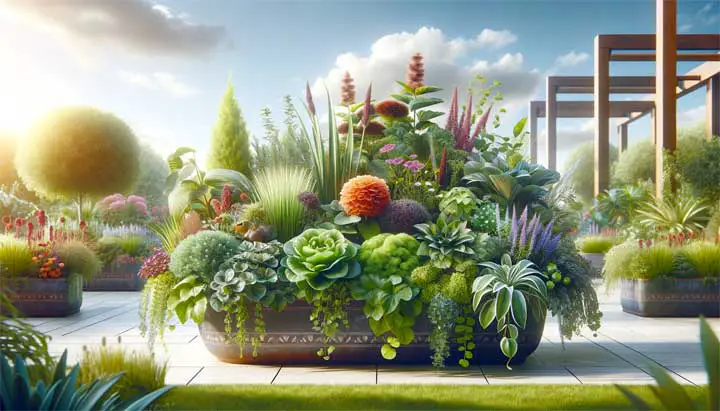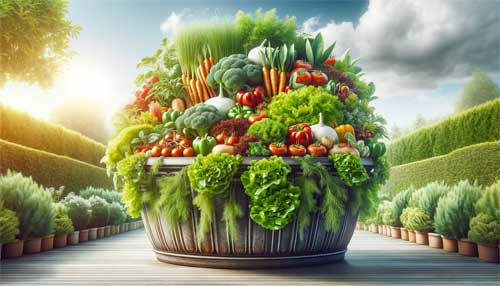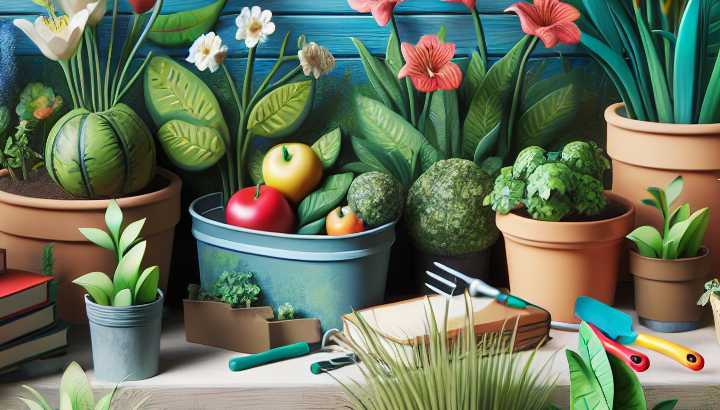Container Gardens: Stunning and Functional
Container gardens are best for those with limited or no outdoor or garden space. Aside from adding beauty to your area, a container garden can be practical. Gardens with the limited space of a balcony, small yard or driveway, can grow a large variety of plants, vegetables, and herbs, which can literally sit outside your kitchen door. Container gardens are ideal for a multitude of reasons: they are easy to maintain, can be easily moved for appropriate sun exposure, and you can coordinate your outdoor décor around it. In this guide, I am going to provide you some tips on how to become the best container gardener you can be!

What exactly are container gardens?
In simple terms, container gardens, or pot gardening, refers to growing a plant in containers versus planting them in the ground. The containers can be anything; from a box, tin, basket, or barrel to a full-size outdoor pot or urn. A container garden (or pot garden) is best for those who have always wanted to plant and garden but have not had the time or actual space for it, or for those who live in areas where the soil is not ideal for growing particular plants. It is the perfect solution because it can be done anywhere, and the benefits are vast.
Benefits of Container Gardening
Many gardeners who have been successful with traditional gardening throughout the years are turning to container gardens for a more manageable way to grow their favorite fruits and vegetables via container plants. They are realizing that they can experience that same “gardening” feeling without all of the work… while still getting their hands dirty
If you are still wondering if this is the way to go, below I have listed a few benefits and tips for practicing container gardening.
For beginners: if you are not successful on your first go, no re-seeding is necessary as with traditional gardening. If the plant dies – and many will – just start over. Easy peasy.
- Versatility: you can use your balcony, patio, courtyard, or windowsills as your “garden”.
- Variety: you can plant just about anything you want in containers: beautiful green, red and purple flowers or add vegetables like squash, peas, sweet peppers, and cucumbers.
- No weeding: avoid the weekly task of weeding.
- Mobility: you can take your container with you wherever you go.
- Water: much less water is needed because water loss via evaporation only occurs from the top layer of soil.
- Companion planting: grouping plants that are good for each other helps prevent disease and insect infestation as well as increases the plants’ growth rate and crop yield. Tomatoes, lettuce, spinach, and strawberries play nicely together and grow very well side by side in containers!

Choosing the right containers for container gardens
This is probably one of the most important tips I can give you in container gardening. And while there are many opinions out there about what can and cannot flourish in container gardens, remember that a successful container garden has more to do with the container size, sunlight, and potting soil quality and less with what specific vegetable you can cultivate. At the end of the day, if the containers are big enough, your options are limitless.
There are many factors that determine how large and deep the planter should be. With respect to pot size, they vary and range from 10 to 24 inches in diameter, with smaller pots being ideal for herbs and larger pots for larger vegetables. Also, you need to take a few things into account; the shape and size of the plant’s root system, whether it is a perennial, annual, or shrub, and how quickly it grows.
Once you have chosen the size you need, your next focus will be which type of planter you want. Below I have some tips on pots to choose from:
- Terracotta: these are the most traditional containers and used by most gardeners because they look attractive, however, they can be pricey, particularly as you go larger making them hard to move if needed. Plants also need to be watered more frequently here because they get very hot and can bake in the sun.
- Glazed Ceramic: these are durable containers and come in a myriad of gorgeous colors, so again, they will beautify your garden, and they do hold more moisture so they will not get as hot as terracotta.
- Plastic: this is a great option if you are on a budget – they are inexpensive, easy to move, and durable.
- Wooden: these are well-liked pots because of their classic look, like bamboo, and they are a great choice for plants that need more room.
- Concrete: if a durable pot is what you are looking for, then this planter is for you. Although they can be more expensive, they will last a lifetime.

Planting your container garden
Now that you have evaluated the type of container or containers you will need for your container garden, it is time to start planting! Remember, this is not like regular patio gardening so following are some tips for you:
- Drainage: Whichever container you go with, drainage holes are a must because, without proper drainage, the soil will become overwatered, the roots will rot and your plant may die. The holes do not need to be large but there needs to be enough of them. You might even have to create them yourself because many garden containers do not come with proper drainage.
- Sunlight: Just like us, different plants prefer different amounts of sunshine. Guide illustrationYou have your sun-loving plants that can stay outside the entire day. Flowering plants and most fruit-producing vegetable plants are sun worshippers needing 5 to 6 hours of direct sunlight in order to thrive. Leafy vegetables and those with ornamental foliage can succeed in partial shade.
- Water: Like any living thing, water is vital – so watering becomes an essential part of your garden planter routine. As mentioned, overwatering causes root rot, so it is important to find just the right amount. You may not be able to assess this at the beginning but in time you will learn how much water your plants need. And when in doubt, check the dampness of the soil with your fingers. In general, it is always better to underwater than overwater. Gardening graphicIf you truly want to be safe, invest in cacti or succulents as these plants store water in their tissues, and can go for long periods of time without water.
- Feeding your plants: Container plants need food to survive. The best way to get nutrients to them is by watering diluted fish emulsion, seaweed extract, or by spraying the leaves with doubly diluted solutions of these ingredients.
- Hardening Off: Plants do not like sudden changes, so it is necessary to acclimate them gradually to any changes in light, the elements, water, and temperature in order to thrive. This is particularly essential for young plants or those who have been sheltered in a greenhouse or nursery. They need time to adjust to the harsher conditions of the real world. This process is called “hardening off”. This basically entails slowly exposing the seedlings or plants to outside conditions, over 6 to 14 days.
- Selecting your plants: You can grow almost kind of plant in pots: from vegetables, flowers, herbs, shrubs, or small trees. It all really depends on what you envision and what your goals are. Are you looking to beautify your space by adding some hanging plants, colorful flowers (such as Lantana), or are you looking to skip the weekly trips to the grocery store by growing your own veggies? Gardening descriptionOr maybe a mix of both?
- Vegetables and Herbs: There is no perfect vegetable to plant in pots but there are some that are better to plant than others. For example, you have the easy ones such as the nightshades; potatoes, peppers, tomatoes, and eggplant, and then you have the faster- growing ones like lettuce and peas. When choosing vegetables, choose small or bush varieties. Whatever you choose, there is nothing better than being able to snip off delicious, freshly grown veggies right outside your own door.
- Annuals and Perennials: We see the words “annual” and “perennial” all over, but do we fully understand what they mean? Basically, annual plants die during the winter season, therefore need to be replanted yearly, versus perennials only need to be planted one time.

So it doesn’t matter if you pick a window box, patio planters, or just old wooden containers you found in the garage, container gardening can be a fun hobby. Fear not! Container gardens are fun and easy – live boldly and just go for it!





